Welche Highlights und Attraktionen dürfen Sie beim Urlaub in Myanmar auf keinen Fall versäumen? Hier finden Sie eine Liste der Top 10 Sehenswürdigkeiten von Myanmar!
Myanmar erinnert ein wenig an Thailand vor dem großen Touristenansturm. Hier ist das Leben noch beschaulich und einfach. Viele Dörfer haben keine Straßen und keinen Strom, Waren werden mit Pferden und Ochsen transportiert und von Handys und W-Lan ist vielerorts noch keine Spur. Myanmar ist somit das perfekte Reiseziel für alle ruhelosen Wanderer, die dringend eine Auszeit benötigen.
Nur auf der faulen Haut zu liegen soll jedoch keineswegs die Empfehlung sein, denn unsere Top 10 Sehenswürdigkeiten von Myanmar sollte jeder Myanmar-Neuling unbedingt auf seiner Liste haben!
Das ehemalige Burma ist eine kulturelle Schatzkiste voller interessanter Sightseeing-Juwelen. Sobald Sie Ihren Streifzug durch die beeindruckenden Pagoden, Buddha-Statuen und Tempel beginnen, werden Sie alsbald verstehen, warum Sie sich im so genannten „Goldenen Land“ befinden. Ebenso faszinierend wie die buddhistische Architektur präsentieren sich die exotische Tier- und Pflanzenwelt, die lebhaften Märkte und die vielfältige Küche. Und nicht zuletzt sorgen auch die Strände von Myanmar für paradiesische Erholung mit Karibik-Feeling.
Tipp: Die beste Reisezeit für Myanmar reicht von November bis Februar, dann ist es meist trocken und die Temperatur angenehm.
Inhaltsverzeichnis
Tempelstadt Bagan

Bagan kann man als touristisches Aushängeschild von Myanmar bezeichnen. In dieser uralten Tempelstadt entstehen die bekannten Fotos, auf denen zu Sonnenaufgang Ballons über spitze Pagoden-Dächer schweben.
Der Großteil der Bauten, die als Abbild des Universums errichtet wurde, stammt aus dem 10. bis 14. Jahrhundert. Sie wurden damals so akribisch gemauert, dass oft nicht mal mehr eine Nadel zwischen die Ziegel passt. Ihr heutiger Zustand reicht von verfallen bis aufwändig restauriert.
Das gewaltige Areal der ehemaligen Hauptstadt des Reiches Pagan umfasst rund 2500 Tempel auf gigantischen 30 Quadratkilometern. Damit zählt Bagan zu den größten archäologischen Stätten Südostasiens. Sie könnten sich mehrere Wochen in Bagan aufhalten und würden immer noch neue Tempel entdecken.
Die meisten Touristen haben allerdings nur einen Tag Zeit, um die imposanten Bauwerke zu besichtigen. Am besten gelingt dies mit dem Mietauto oder dem Fahrrad.
Unbedingt gesehen haben sollten Sie:
- die Shwezigon-Pagode (der Inbegriff einer burmesischen Pagode)
- den Ananda-Tempel (den heiligsten Tempel Pagans)
- den Thatbinnyu-Tempel (das höchste Gebäude in Bagan)
- den Dhamma Yangyi-Tempel (zwischen seinen kostbaren Wandmalereien soll es spuken)
- die Shwesandaw-Pagode (ein klassischer Treffpunkt zu Sonnenuntergang)
- den Nan Myint Turm oder die Pyathada Pagode (mit wunderbarem Überblick über die Tempelstadt von Bagan)
- den Sulamani-Tempel, eines der bedeutendsten Klöster von Bagan
Shwedagon Pagode in Yangon (Rangun)
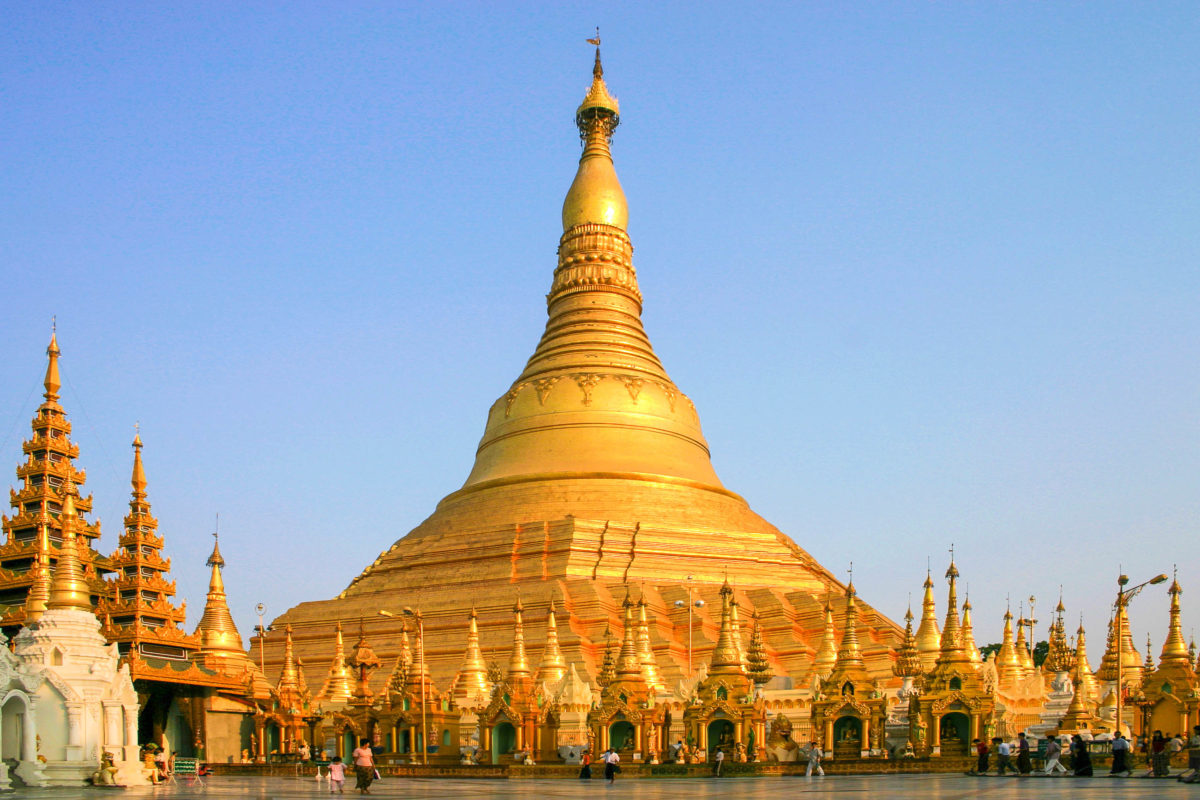
Auch wer nach einem Besuch in Bagan glaubt, schon alles gesehen zu haben: Beim Anblick der gewaltigen goldenen Shwedagon Pagode in Yangon stockt jedem Betrachter der Atem. Der 100 Meter hohe Stupa ist das bedeutendste buddhistische Heiligtum von Myanmar, zählt zu den wichtigsten Pilgerstätten des Buddhismus und lockt jeden Tag tausende Menschen an.
60 Tonnen Blattgold und die edelsteinbesetzte Spitze lassen die Pagode überirdisch erstrahlen. Alleine die Wetterfahne ist mit über 1.000 Diamanten, Saphiren und Rubinen geschmückt.
Besonders am Abend wird es um die Shwedagon Pagode laut und voll. Wenn sich im Schein der untergehenden Sonne unzählige Gläubige versammeln, um zu plaudern, zu beten oder zu meditieren herrscht nahezu Volksfest-Stimmung. Am Morgen ist es dagegen meist ruhig und man kann die spirituelle Atmosphäre im Stupa und den zugehörigen Schreinen in Ruhe genießen.
Tipp: In Rangun ist auch der Chaukhtatgyi-Buddha-Tempel sehenswert. Hier befindet sich eine der längsten liegenden Buddha-Statuen der Welt.
Shwemawdaw Pagode in Bago

Die Shwedagon Pagode ist das bekannteste Heiligtum Myanmars – die Shwemawdaw Pagode in Bago hält auch einen Rekord. Mit 114 Metern ist sie die höchste Pagode von Myanmar. Der gewaltige goldene Stupa stammt aus dem 10. Jahrhundert. Er wurde allein im 20. Jahrhundert dreimal durch Erdbeben zerstört und jedes Mal – ein wenig prächtiger als zuvor – wieder aufgebaut.
Die Pilger beten, meditieren, singen, plaudern (und füllen die Spendenboxen). Zum 10tägigen Festival im April finden sie sich in Scharen am Fuß des beeindruckenden Heiligtums ein. Dennoch herrscht hier eher selten Trubel, die Stimmung ist meist ruhig und besinnlich.
Tipp: Bago ist der ideale Zwischenstopp auf der Reise von Rangun zum Goldenen Felsen! Außer der Shwemawdaw Pagode zählen noch weitere Pagoden, imposante Buddha-Statuen, Königstempel und Klöster zu den Sehenswürdigkeiten von Bago.
Goldener Felsen von Kyaiktiyo
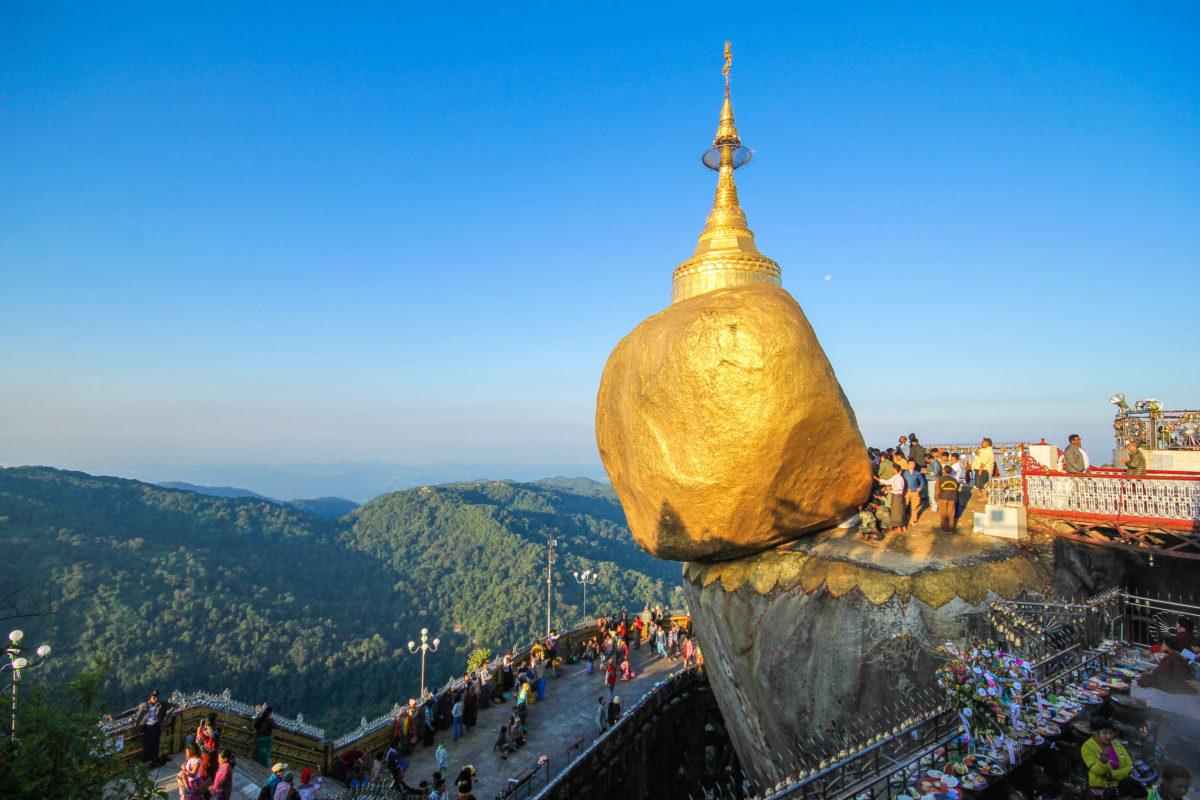
Als „Goldener Felsen“ oder „Golden Rock“ wird eine der bedeutendsten Pilgerstätten Myanmars bezeichnet. Der riesige vergoldete Stein mit dem ebenfalls goldenen Stupa darauf liegt in der Nähe von Kyaiktiyo auf der Spitze des gleichnamigen Berges. Der Legende nach wurde er mit einem Schiff vom Meeresgrund auf seinen heutigen Platz verfrachtet. Drei goldene Haare des Buddha halten ihn seither an seinem Platz.
Auch für Nicht-Pilger ist die größte Attraktion am Goldenen Felsen die spirituelle Atmosphäre, die jeden Tag rund 10.000 Besucher unweigerlich in ihren Bann zieht. Der heilige Ort ist von einer wunderbaren Ruhe erfüllt, die sofort und völlig unbewusst in sich gehen lässt. Die Gläubigen beten, singen, bringen Opfergaben dar, zünden Kerzen an und suchen das Gespräch mit Buddha.
Zu erreichen ist der Golden Rock entweder über einen 1,5 Stunden langen Fußmarsch oder per 45minütiger Truck-Fahrt von Kinpun aus. Am schnellsten geht’s allerdings mit der Seilbahn – von Yathetaung aus dauert die Fahrt maximal 15 Minuten. Abgesehen vom friedvollen Ambiente ist auch die Aussicht vom Goldenen Felsen aus absolut überwältigend.
Strand von Ngapali
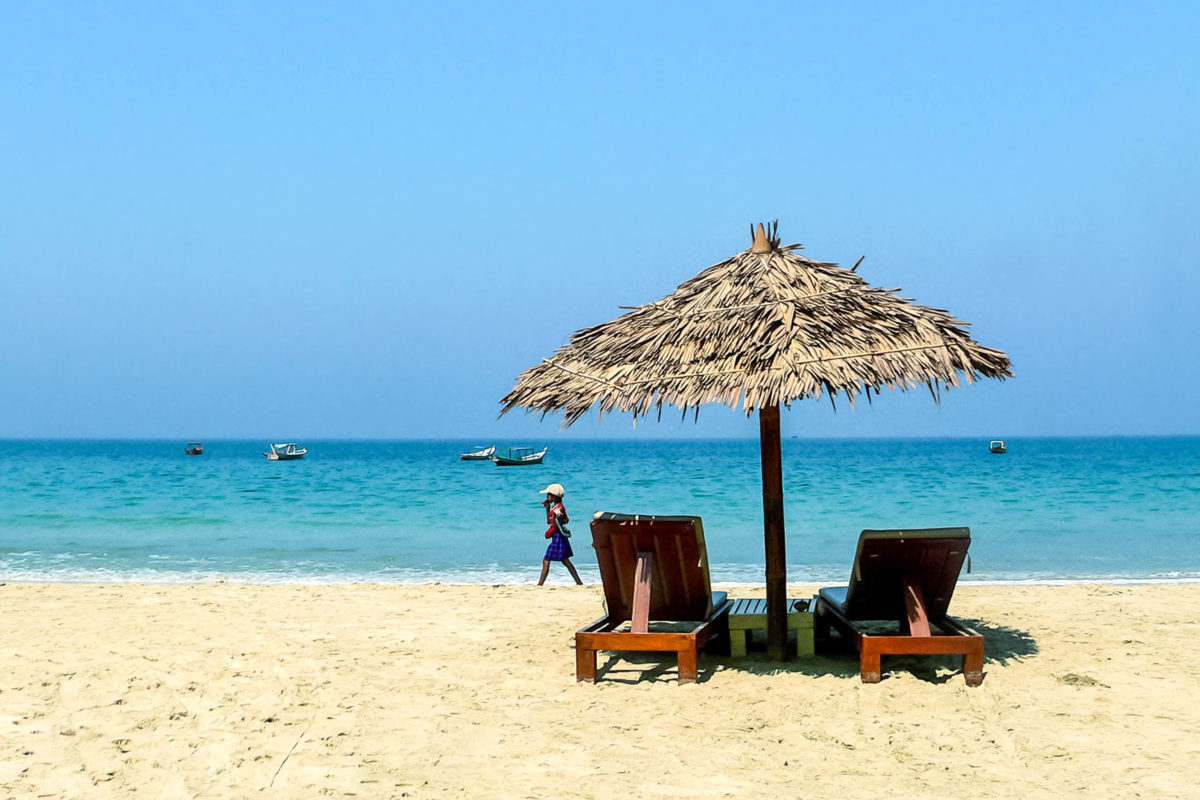
Der Strand von Ngapali im Westen des Landes ist der schönste und beliebteste Strand von Myanmar. Feiner Sand, Palmen und glasklares Meer laden zum Sonnenbaden und Schwimmen ein, die Fischmenüs direkt am Strand sind vorzüglich und äußerst preisgünstig.
Der 8 Kilometer lange Ngapali-Strand eignet sich perfekt für einen entspannten Badetag, um sich zwischendurch etwas vom Sightseeing zu erholen. Die meisten (eher hochpreisigen) Hotels und Restaurants liegen am südlichen Abschnitt des Strandes, hier ist auch am meisten los. Trotzdem ist der Strand selten überlaufen und ein ruhiges Plätzchen immer noch auffindbar.
Tipp: Im Norden des Strandes liegt der Flughafen – je näher man diesem kommt desto lauter wird leider auch das Dröhnen der Motoren.
Inle See
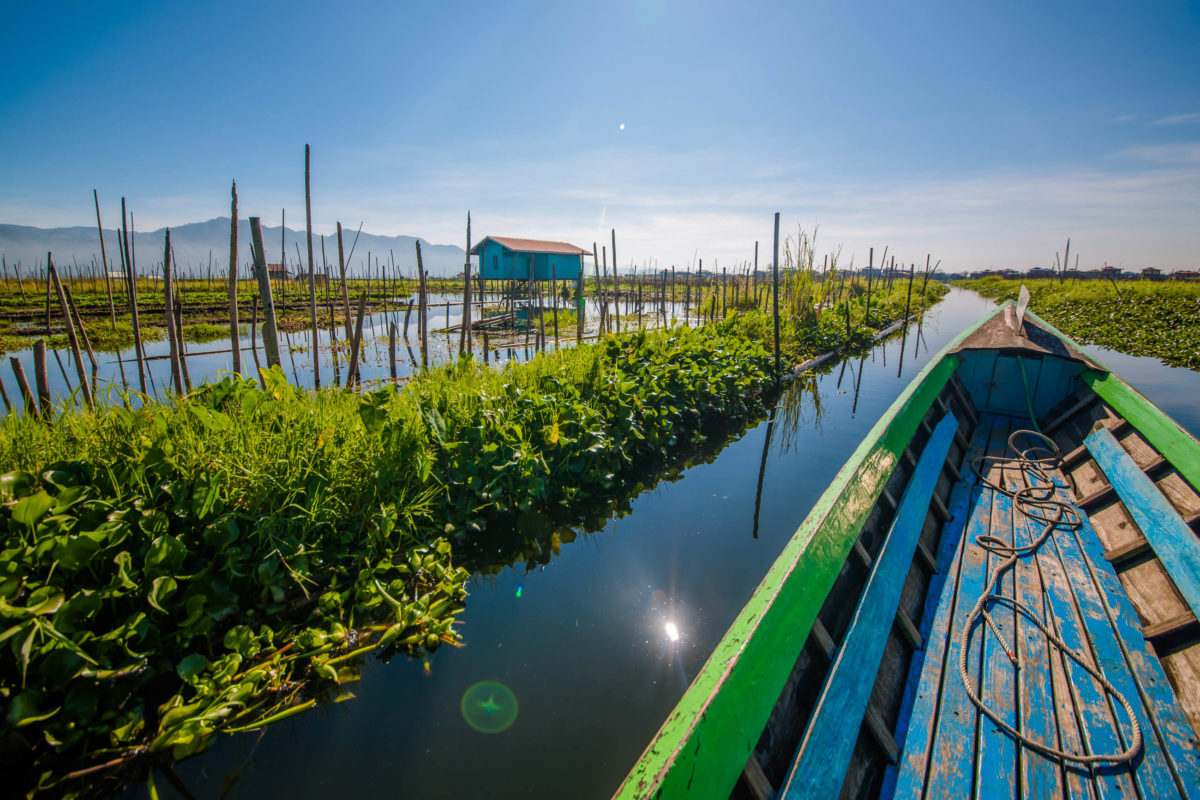
Der inmitten von Bergen malerisch gelegene Inle See zählt zu den idyllischsten Reisezielen im Myanmar-Urlaub. Die hier ansässigen „Intha“, die „Menschen vom See“, führen das geruhsame Leben von Fischern, Bauern, Bootsfahrern oder Handwerkern und leben in ihren kleinen Ortschaften und Städtchen den traditionellen burmesischen Alltag im Einklang mit der Natur. Auch das Kayan-Volk lebt hier, dessen Frauen sich ihre Hälse mit Hilfe von unzähligen Ringen in die Länge ziehen.
Um alle Sehenswürdigkeiten des Inle Sees ausgiebig zu genießen bietet sich ein Aufenthalt von drei bis fünf Tagen an. Bootstouren auf dem überraschend sauberen See können in so gut wie jedem Hotel oder Tourismus-Büro gebucht werden. Meist von der kleinen Stadt Nyaung Shwe aus geht es dann über einen Kanal auf dem strahlend blauen Wasser durch schwimmende Dörfer, Märkte und Gärten.
Zwischenstopps an den Ufern bieten sich an, um Pagoden und Klöster zu besichtigen oder einfach nur die Fischer in ihren Longboats und die akrobatischen Ruderer auf einem Bein zu beobachten.
Pindaya Höhlen

Wer auf seiner Myanmar-Reise am Inle-See Station macht, sollte auch die Pindaya-Höhlen etwa 2 Autostunden entfernt besuchen. In der südlichsten der drei gigantischen Kalksteinhöhlen befinden sich ähnlich wie in den Pak Ou Höhlen bei Luang Prabang in Laos an die 8000 goldene Buddha-Figuren. Die Statuen aus Gips, Stein, Holz, Zement oder Bronze gehen bis ins 18. Jahrhundert zurück und werden stetig mehr.
Der Sage nach wurden in den Pindaya Höhlen einst sieben Prinzessinnen von einer Riesen-Spinne gefangen gehalten, bis sie von einem Prinz mittels Pfeil und Bogen getötet wurde. Ein Prachtexemplar des achtbeinigen Insekts und eine Statue des mutigen Retters begrüßen die Touristen am Eingang zum Höhlenlabyrinth.
Die scheinbar endlose Treppe zum Eingang der Tropfsteinhöhle kann auch mit einem Lift überwunden werden. Vorm Betreten der feucht-warmen Höhle heißt es übrigens: Schuhe ausziehen! Sehr sauber ist der Boden darin allerdings leider nicht…
U-Bein-Brücke am Taung Tha Man See

Am malerischen Taung Tha Man See in der alten Königsstadt Amarapura bei Mandalay ist die U-Bein-Brücke die meistfotografierte Sehenswürdigkeit. Die 1,2 Kilometer lange Brücke ist die längste Teakholz-Brücke der Welt. Sie wird seit ihrer Erbauung im Jahr 1859 von tausenden hölzernen Pfählen über Wasser gehalten. Je nach Wasserstand des Sees steht die Brücke allerdings manchmal auch völlig auf dem Trockenen. Der Name der Brücke erinnert übrigens an ihren Auftraggeber.
Am Abend füllt sich die U-Bein-Brücke mit hunderten Touristen, um das Schauspiel des Sonnenuntergangs zu genießen. Dies nutzen zahlreiche Souvenir-Verkäufer, die an ihren Ständen auf und um die Brücke Urlaubserinnerungen aller Art anbieten. In kleinen Restaurants am Taung Tha Man See kann mit Blick auf die malerische U-Bein-Brücke gespeist werden.
Tipp: Am Abend ist auf der Brücke einiges los, am Morgen hingegen hat man das berühmte Teakholz-Bauwerk fast für sich alleine – dies ist daher auch die beste Zeit für Fotografen.
Indawgyi See und Pagode Shwemyintzu
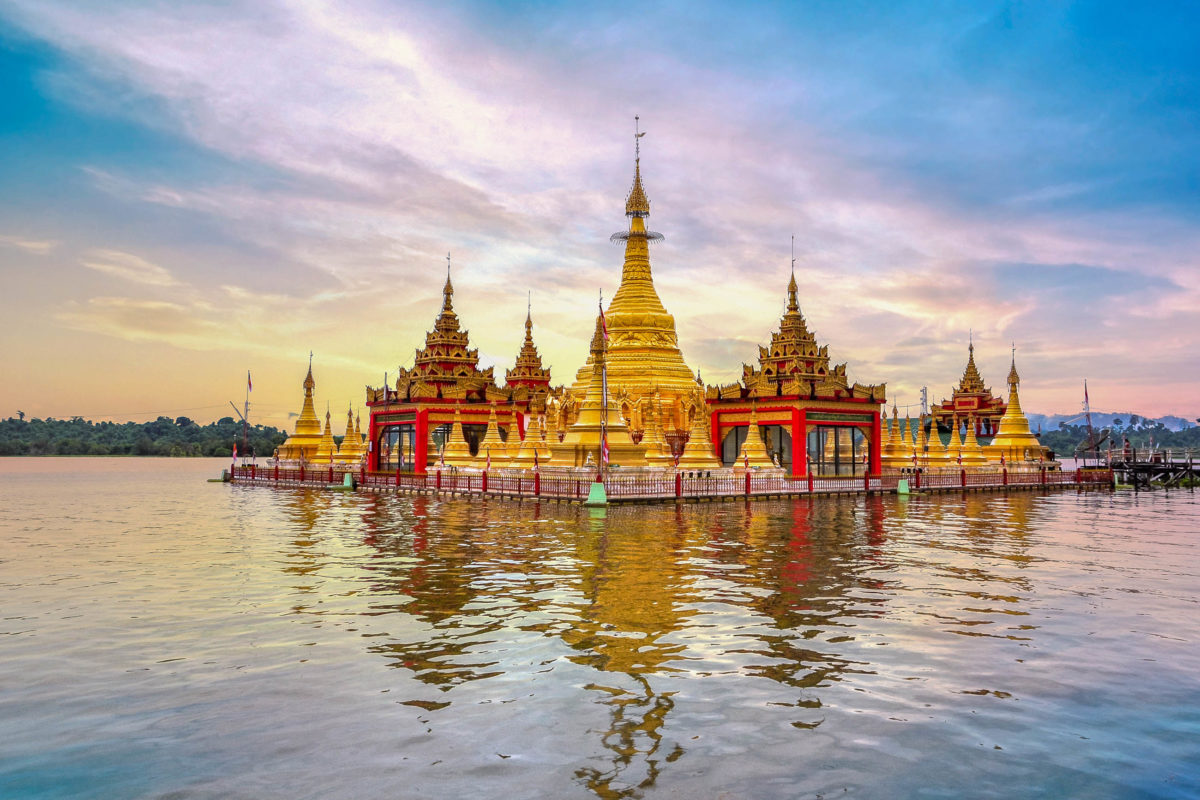
Die goldglänzende Shwemyintzu Pagode zählt aufgrund ihrer malerischen Lage im Indawgyi See zu den schönsten buddhistischen Heiligtümern von Myanmar. Auch der See im Norden von Myanmar ist eine Sehenswürdigkeit, denn in seiner geruhsamen Umgebung leben die Menschen noch von Fischfang und Reisanbau. Zahlreiche Zugvögel legen hier jedes Jahr auf ihrer Reise von Sibirien nach Australien eine Rastpause ein.
Die Shwemyintzu Pagode befindet sich auf einer künstlichen Insel im „königlichen See“ und zieht unter den 36 Dörfern an seinen Ufern am meisten Touristen an. Die goldene Pagode kann vom Ufer aus über einen Fußweg erreicht werden (es gibt auch einen zweiten Weg, der ist allerdings den Göttern vorbehalten).
Das Festival an der Shwemyintzu Pagode lockt jedes Jahr an die 100.000 Pilger an den Indawgyi See. Abgesehen davon steckt der Tourismus auf diesem Fleckchen von Myanmar noch in den Kinderschuhen.
Mingun-Pagode
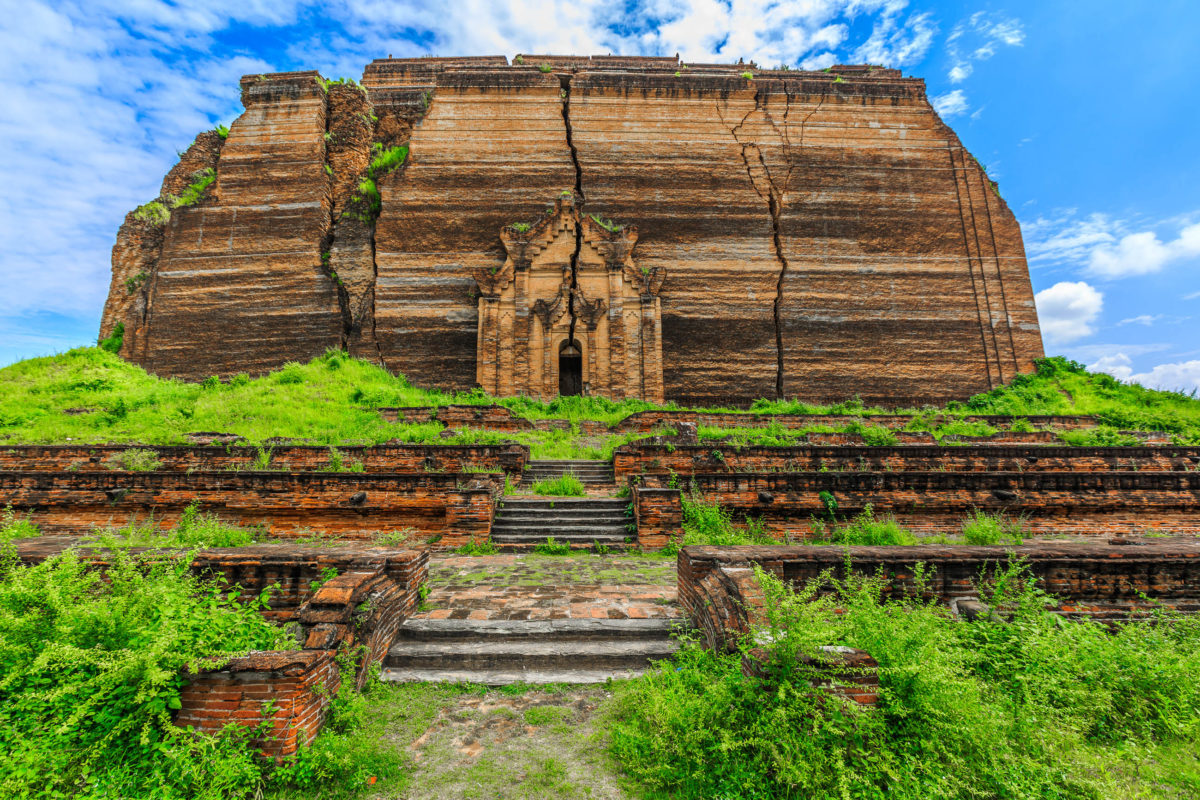
Etwas nördlich von Mandalay liegt mit der Pagode im Dorf Mingun ein weiteres buddhistisches Heiligtum, welches unter den Top 10 Sehenswürdigkeiten von Myanmar einen Platz verdient hat.
Das gewaltige Bauwerk sollte einst die größte Pagode der Welt werden, ist jedoch bis heute unvollendet. König Bodawpaya wollte mit der Errichtung der 152 Meter hohen Pagode seine Macht und seinen Reichtum demonstrieren. Außerdem sollte sie einen Zahn Buddhas enthalten, den ihm der Kaiser von China als Geschenk gesandt hatte.
Der Bau des Monumental-Projekts begann im Jahr 1790, wurde jedoch nie fertiggestellt. König Bodawpaya verstarb 1819 und so steht bis heute nur das 72 Meter lange und 50 Meter hohe Fundament der Mingun-Pagode. Obwohl nur zu einem Drittel vollendet, ist sie dennoch eindrucksvoll anzusehen.




